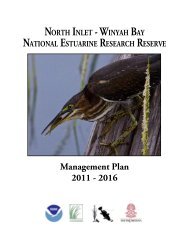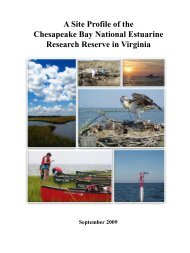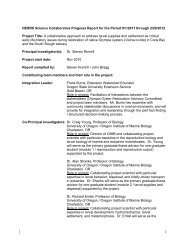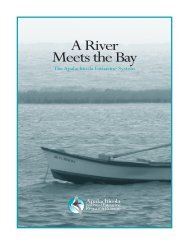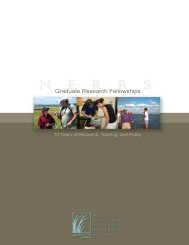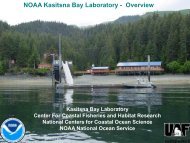- Page 1 and 2: CHARACTERIZATION OF THE JACQUES COU
- Page 3 and 4: National Estuaries Day 37 Graduate
- Page 5: HABITATS 132 Watershed 132 Overview
- Page 9 and 10: A wide range of aquatic habitats ex
- Page 11 and 12: Nutrient enrichment fuels rapid phy
- Page 13 and 14: community is needed, as well as sur
- Page 15 and 16: The NERRS also promotes increased p
- Page 17 and 18: monitoring; and (3) land use and ha
- Page 19 and 20: sampler (Teledyne Isco, Inc., Linco
- Page 21 and 22: II) examines the community and vege
- Page 23 and 24: This component of the SWMP enables
- Page 25 and 26: development (Psuty et al., 1993). D
- Page 27 and 28: Scientific investigations in the JC
- Page 29 and 30: awarded from NOAA/NERRS to renovate
- Page 31 and 32: As a follow-on program, the CTP off
- Page 33 and 34: aquatic vegetation (SAV) to staff o
- Page 35 and 36: conducted by Summer Institute parti
- Page 37 and 38: National Estuaries Day On behalf of
- Page 39 and 40: km 2 offshore research site of Rutg
- Page 41 and 42: Climate A number of weather station
- Page 43 and 44: Northwesterly winds in winter devel
- Page 45 and 46: Age (overlain by a thin veneer of Q
- Page 47 and 48: Table 1. Upper strata of the New Je
- Page 49 and 50: The Mullica River watershed contain
- Page 51 and 52: Klej Sassafras Entire region Hamm o
- Page 53 and 54: the Pine Barrens, including over 10
- Page 55 and 56: later converted into a paper mill.
- Page 57 and 58:
Figure 8. Distribution of developed
- Page 59 and 60:
Zampella et al. (2001) investigated
- Page 61 and 62:
several disturbance-related scrub/s
- Page 63 and 64:
covered an estimated 1.34% of the M
- Page 65 and 66:
Figure 10. Location of the New Jers
- Page 67 and 68:
aluminum; (2) lower concentrations
- Page 69 and 70:
creeks (i.e., Thompson Creek, Ezras
- Page 71 and 72:
from soil and ground water ______ _
- Page 73 and 74:
also tend to be retained in the bay
- Page 75 and 76:
exchange within the backbay system
- Page 77 and 78:
Figure 14. Synoptic current field d
- Page 79 and 80:
The most comprehensive database on
- Page 81 and 82:
Analysis of the SWMP database is on
- Page 83 and 84:
monitoring key physical and chemica
- Page 85 and 86:
and characterize benthic environmen
- Page 87 and 88:
striped bass, and bluefish. Acousti
- Page 89 and 90:
of disturbance typically occur. Alt
- Page 91 and 92:
Conway, 2001). Along a watershed di
- Page 93 and 94:
Durand (1984, 1998) has discussed t
- Page 95 and 96:
McGuirk Flynn (2008) examined how t
- Page 97 and 98:
Estuarine Water Quality Able et al.
- Page 99 and 100:
Each YSI data logger is inserted in
- Page 101 and 102:
eing pH 7 followed by pH 4. The low
- Page 103 and 104:
RUMFS. These data are fed to the In
- Page 105 and 106:
direction, and all data are availab
- Page 107 and 108:
Sensors on the weather station are
- Page 109 and 110:
did not occur at the study site, su
- Page 111 and 112:
(ANOVA) models were run using the S
- Page 113 and 114:
The mean temperature at Chestnut Ne
- Page 115 and 116:
tests, the mean salinity at Buoy 12
- Page 117 and 118:
There was no significant difference
- Page 119 and 120:
In 1999, the mean values of pH reco
- Page 121 and 122:
Depth Figure 25 shows water depths
- Page 123 and 124:
Temperature Because of the shallow
- Page 125 and 126:
exceeded 10‰ at the SWMP sites du
- Page 127 and 128:
December 2008. This is attributed p
- Page 129 and 130:
potential indicator of Pinelands wa
- Page 131 and 132:
Depth Tidal action accounted for mu
- Page 133 and 134:
depressions and as narrow bands alo
- Page 135 and 136:
oak (Pinus-Quercus) trees form the
- Page 137 and 138:
peregrina), and sand myrtle (Leioph
- Page 139 and 140:
(Betula populifolia) are of seconda
- Page 141 and 142:
Table 7. Disturbance-indicator plan
- Page 143 and 144:
stream banks and locally within the
- Page 145 and 146:
characterized by sparsely vegetated
- Page 147 and 148:
complex of salt marsh islands exist
- Page 149 and 150:
each pea (Lathyrus maritimus), Japa
- Page 151 and 152:
Ampelisca abdita. Benthic organisms
- Page 153 and 154:
impaired. The net insidious effect
- Page 155 and 156:
spatial comparison analysis of SAV
- Page 157 and 158:
estuary, it will be possible to com
- Page 159 and 160:
159 also supports numerous species
- Page 161 and 162:
Table 8. Status of amphibians and r
- Page 163 and 164:
Northern water snake Abundant North
- Page 165 and 166:
and (3) those forms normally unable
- Page 167 and 168:
• The general absence of the two
- Page 169 and 170:
Most turtles in the Pine Barrens oc
- Page 171 and 172:
mortality, illegal collecting and w
- Page 173 and 174:
numerous migrating birds to utilize
- Page 175 and 176:
terns (common terns, Forster's tern
- Page 177 and 178:
Tri-colored heron Egretta tricolor
- Page 179 and 180:
The osprey, peregrine falcon, and n
- Page 181 and 182:
are mainly observed in open waters
- Page 183 and 184:
Table 11. Waterfowl species occurri
- Page 185 and 186:
predators. Species generally occur
- Page 187 and 188:
in these peripheral areas. The chan
- Page 189 and 190:
Table 12. Taxonomic list of fish co
- Page 191 and 192:
sollicitans, A. cantator, A. taenio
- Page 193 and 194:
and they are prey of various predac
- Page 195 and 196:
Phytoplankton The principal primary
- Page 197 and 198:
Ochromonas Wyssotzki (sp.) X Pavlov
- Page 199 and 200:
Cocconeis Ehrenberg (sp.) (/) Nanno
- Page 201 and 202:
(Peridinium Ehrenberg) X C. amphiox
- Page 203 and 204:
concentrations of organic nitrogen
- Page 205 and 206:
three principle criteria: size, tax
- Page 207 and 208:
Table 14. Monthly mean abundance of
- Page 209 and 210:
to the spring and summer microzoopl
- Page 211 and 212:
sapidus, Argopecten irradians, and
- Page 213 and 214:
Figure 26. Benthic invertebrate sam
- Page 215 and 216:
Order Actiniaria Diadumene leucolen
- Page 217 and 218:
Glycera capitata Oersted Glycera di
- Page 219 and 220:
Family Dorvilleidae Stauronereis ru
- Page 221 and 222:
Class Crustacea Order Thoracica Bal
- Page 223 and 224:
Unciola irrorata Say Family Ampitho
- Page 225 and 226:
Crepidula convexa Say Crepidula fro
- Page 227 and 228:
Laevicardium mortoni Conrad Macoma
- Page 229 and 230:
Figure 27. Species richness (number
- Page 231 and 232:
higher percentages of silt and clay
- Page 233 and 234:
Arca pexata Brania clavata Crepidul
- Page 235 and 236:
Figure 28. Density (number of organ
- Page 237 and 238:
Figure 29. Topographic structure of
- Page 239 and 240:
Eelgrass and widgeon grass occur al
- Page 241 and 242:
comparison analysis of SAV surveys
- Page 243 and 244:
during the three-year study period
- Page 245 and 246:
In 2005, the percent cover of seagr
- Page 247 and 248:
The three-year SAV investigation (2
- Page 249 and 250:
ilinearis), spotted hake (Urophycis
- Page 251 and 252:
numerical dominance of a few specie
- Page 253 and 254:
Except for the aforementioned seaso
- Page 255 and 256:
Bluefish (Pomatomus saltatrix) In t
- Page 257 and 258:
migratory stocks, with the former p
- Page 259 and 260:
the South Atlantic Bight. There are
- Page 261 and 262:
winter flounder considers the speci
- Page 263 and 264:
long and females 15.2 to 20.3-cm lo
- Page 265 and 266:
The JCNERR also supports several sp
- Page 267 and 268:
ENDANGERED AND THREATENED SPECIES O
- Page 269 and 270:
are recognized as having outstandin
- Page 271 and 272:
aquatic habitats almost entirely in
- Page 273 and 274:
water quality monitoring stations o
- Page 275 and 276:
Rutgers University Coastal Ocean Ob
- Page 277 and 278:
components of the total zooplankton
- Page 279 and 280:
phytoplankton rate processes. The o
- Page 281 and 282:
• Do the SAV bed boundaries expan
- Page 283 and 284:
have been treated to restore natura
- Page 285 and 286:
REFERENCES Able, K. W. and S. M. Ha
- Page 287 and 288:
Bologna, P. A. X., R. Lathrop, P. D
- Page 289 and 290:
Conant, R. 1998. A zoogeographical
- Page 291 and 292:
Epifanio, C. E., C. C. Valenti, and
- Page 293 and 294:
Heck, K. L., Jr. and T. A. Thoman.
- Page 295 and 296:
Kennish, M. J. and A. R. Townsend.
- Page 297 and 298:
MacDonald, W. B. 1983. Coastal-estu
- Page 299 and 300:
Moser, F. C. 1997. Sources and Sink
- Page 301 and 302:
Nichols, T. C. and P. M. Castelli.
- Page 303 and 304:
Pihl, L., S. P. Baden, R. J. Diaz,
- Page 305 and 306:
experiments and data synthesis. Jou
- Page 307 and 308:
Viscido, S. V., D. E. Stearns, and
- Page 309 and 310:
Zapecza, O. S. 1989. Hydrologic Fra
- Page 311 and 312:
Appendix 2. A Build-out Analysis of
- Page 313 and 314:
development, permanently protected
- Page 315 and 316:
4. High constraints scenario three
- Page 317 and 318:
The NJDEP estimated impervious surf
- Page 319 and 320:
Lower Mullica River 6.84 7.52 7.76
- Page 321 and 322:
Figure 4. Build-out impervious surf
- Page 323 and 324:
ACKNOWLEDGEMENTS The Pinelands Comm
- Page 325 and 326:
Appendix 3. A Build-out Analysis of
- Page 327 and 328:
easons (e.g., consists of wetlands
- Page 329 and 330:
downstream, Barnegat Bay is on the
- Page 331 and 332:
Impervious Surface In 1986, the wat
- Page 333 and 334:
space by the Century Plan. If the l
- Page 335 and 336:
Blanchard, P. Beyond the Century Pl
- Page 337 and 338:
Appendix 4. Summary of nutrient, pr
- Page 339 and 340:
Appendix 6. Mean monthly salinity r
- Page 341 and 342:
Appendix 8. Mean high tide (height
- Page 343 and 344:
Appendix 10. Summary statistics for
- Page 345 and 346:
Table 1. Lower Bank 1999 (Depth and
- Page 347 and 348:
Table 2. Lower Bank 2000 (Temperatu
- Page 349 and 350:
Table 2. Lower Bank 2000 (Depth and
- Page 351 and 352:
Table 3. Chestnut Neck 1999 (Temper
- Page 353 and 354:
Table 3. Chestnut Neck 1999 (Depth
- Page 355 and 356:
Table 4. Chestnut Neck 2000 (Temper
- Page 357 and 358:
Table 4. Chestnut Neck 2000 (Depth
- Page 359 and 360:
Table 5. Buoy 126 1999 (Temperature
- Page 361 and 362:
Table 5. Buoy 126 1999 (Depth and p
- Page 363 and 364:
Table 6. Buoy 126 2000 (Temperature
- Page 365 and 366:
Table 6. Buoy 126 2000 (Depth and p
- Page 367 and 368:
Appendix 11. Results of ANOVAs comp
- Page 369 and 370:
Appendix 13. Statistical tests comp
- Page 371 and 372:
Appendix 14. Taxonomic list of plan
- Page 373 and 374:
Tussock sedge Carex stricta Blunt b
- Page 375 and 376:
Green wood orchid Habenaria clavell
- Page 377 and 378:
Forked panic-grass Panicum dichotom
- Page 379 and 380:
Canada goldenrod Solidago canadensi
- Page 381 and 382:
Dangleberry Gaylussacia frondosa Go
- Page 383 and 384:
Fox grape Vitis labrusca __________
- Page 385 and 386:
Cylindrocapsa sp. Stigeoclonium spp
- Page 387 and 388:
G. monotaenium De Bary Cylindrocyst
- Page 389 and 390:
C. setaceum Ehr. C. striolatum Ehr
- Page 391 and 392:
E. insulare (Wittr.) Roy E. interme
- Page 393 and 394:
M. denticulata Bréb. M. depauperat
- Page 395 and 396:
S. leptacanthum Nordst. var. tetroc
- Page 397 and 398:
P. longicauda (Ehr.) Duj. P. pleuro
- Page 399 and 400:
Order CENTRALES Melosira sp. Order
- Page 401 and 402:
Nitzschia sigmatella Greg. Nitzschi
- Page 403 and 404:
Batrachospermum brugiense Sirod. B.
- Page 405 and 406:
Bitterns, Herons, and Ibises Rails
- Page 407 and 408:
Plovers and Sandpipers Cooper's haw
- Page 409 and 410:
Kinglets and Thrashers Blackbirds a
- Page 411 and 412:
Sparrows and Tanagers Blackburnian
- Page 413 and 414:
Estuarine Shores: Evolution, Enviro
- Page 415 and 416:
chlorphyrifos on the aquatic insect
- Page 417 and 418:
Denno, R.F. and H. Dingle. 1981. Co
- Page 419 and 420:
Denno, R.F. and G.K. Roderick. 1990
- Page 421 and 422:
601 pp. Fowler, T. (ed.) 1993. A wa
- Page 423 and 424:
Science 139(1): 21-29 Keefe, M. and
- Page 425 and 426:
Kennish, M. J. 2000. Barnegat Inlet
- Page 427 and 428:
Laudan, R., J.S. Stolen, and A. Cal
- Page 429 and 430:
Neuman, M.J. 1996. Evidence of upwe
- Page 431 and 432:
Rountree, R.A. and K.W. Able. 1997.
- Page 433 and 434:
larval and juvenile summer flounder
- Page 435 and 436:
vascular macrophytes of the tidal M
- Page 437 and 438:
young-of-year bluefish, Pomatomus s
- Page 439 and 440:
community at Beach Haven Ridge, New
- Page 441 and 442:
and Coastal Sciences, Tech. Rept. 9
- Page 443 and 444:
Boriek, M. 1979. Evaluation of the
- Page 445 and 446:
waters near 39Ε28'N Latitude and 7
- Page 447 and 448:
coastal waters near 39Ε28'N Latitu
- Page 449 and 450:
39Ε28'N Latitude and 74Ε15'W Long
- Page 451 and 452:
Goldberg, R., A. Studholme, A. Cala
- Page 453 and 454:
Joseph, J.W. 1980. Evaluation of th
- Page 455 and 456:
Kennish, M. J., S. M. Haag, and G.
- Page 457 and 458:
estuary. NJDEP, Div. Fish, Game She
- Page 459 and 460:
Rhodehamel, E.C. 1970. A hydrologic
- Page 461 and 462:
Wyllie, M.C., E.R. Holmstrom and R.
- Page 463 and 464:
Jivoff, P.R. and K.W. Able. 2003. B
- Page 465 and 466:
Able, K.W., S.M. Hagan, K. Kovitvon
- Page 467 and 468:
Theses and Dissertations Edward Mar
- Page 469 and 470:
Warlen, S.M., K.W. Able and E. Laba
- Page 471 and 472:
Able, K.W. S.M. Hagan, J. McLellan
- Page 473 and 474:
Appendix 19. Taxonomic list of bent
- Page 475 and 476:
Lumbrineris tenuis (Verrill) Maldin
- Page 477 and 478:
Turbonilla sp. Urosalpinx cinera (S
- Page 479 and 480:
Lysianopsis alba (Holmes) Melita ni
- Page 481 and 482:
Appendix 20. Taxonomic list of fish
- Page 483 and 484:
Mugil curema White mullet S, T, W M
- Page 485 and 486:
Appendix 21. A list of state- and f
- Page 487 and 488:
Minute duckweed Lemna perpusilla En
- Page 489 and 490:
Virginia thistle Cirsium virginianu
- Page 491 and 492:
Black-crowned night-heron Nycticora
- Page 493 and 494:
Appendix 22. Federal listing of thr





